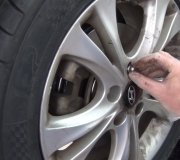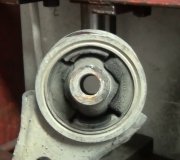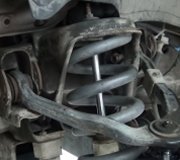Welcome back:
It sounds like what you did with the rear will be okay, but they need bleed. Here is a link that shows how to bleed and flush the brakes. You only need to worry about bleeding them:
https://www.2carpros.com/articles/how-to-bleed-or-flush-a-car-brake-system
Now, since you only replaced the left front brake caliper, if the master cylinder never went empty, you should only have to bleed that caliper. However, here are the directions for doing all the wheels. Again, if the MC never was empty, the only place that air could have entered was when you were working on the caliper, so focus on that. By the way, you will need a helper. The helper will pump the brakes aprox 5 times and then hold pressure on the brake pedal. Next, open the bleeder on the caliper. Air and fluid will come out. While it is coming out, the brake pedal will go to the floor. Tell the helper to not release the brake pedal until you tighten the bleeder. If it is released before you seal the bleeder shut, it will suck more air back into the system.
Here are the directions. If the MC did go empty, let me know. Also, I started at number 5 because the directions prior were for the MC.
_________________________________
5. Install a proper box-end wrench onto the RIGHT REAR wheel hydraulic circuit bleeder valve.
6. Install a transparent hose over the end of the bleeder valve.
7. Submerge the open end of the transparent hose into a transparent container partially filled with Delco Supreme 11(R), GM P/N 12377967 (Canadian P/N 992667), or equivalent DOT-3 brake fluid from a clean, sealed brake fluid container.
8. Have an assistant slowly depress the brake pedal fully and maintain steady pressure on the pedal.
9. Loosen the bleeder valve to purge air from the wheel hydraulic circuit.
10. Tighten the bleeder valve, then have the assistant slowly release the brake pedal.
11. Wait 15 seconds, then repeat steps 8-10 until all air is purged from the same wheel hydraulic circuit.
12. With the right rear wheel hydraulic circuit bleeder valve tightened securely, after all air has been purged from the right rear hydraulic circuit install a proper box-end wrench onto the LEFT REAR wheel hydraulic circuit bleeder valve.
13. Install a transparent hose over the end of the bleeder valve, then repeat steps 7-11.
14. With the left rear wheel hydraulic circuit bleeder valve tightened securely, after all air purged from the left rear hydraulic circuit, install a proper box-end wrench onto the RIGHT FRONT wheel hydraulic circuit bleeder valve.
15. Install a transparent hose over the end of the bleeder valve, then repeat steps 7-11.
16. With the right front wheel hydraulic circuit bleeder valve tightened securely, after all air has been purged from the right front hydraulic circuit, install a proper box-end wrench onto the LEFT FRONT wheel hydraulic circuit bleeder valve.
17. Install a transparent hose over the end of the bleeder valve, then repeat steps 7-11.
18. After completing the final wheel hydraulic circuit bleeding procedure, ensure that each of the 4 wheel hydraulic circuit bleeder valves are properly tightened.
19. Fill the brake master cylinder reservoir to the maximum-fill level with Delco Supreme 11(R), GM P/N 12377967 (Canadian P/N 992667), or equivalent DOT-3 brake fluid from a clean, sealed brake fluid container.
20. Slowly depress and release the brake pedal. Observe the feel of the brake pedal.
21. If the brake pedal feels spongy, repeat the bleeding procedure again.
__________________________________________
I hope this helps. Let me know if you have other questions. And also let me know if this fixes the problem.
Take care,
Joe
Monday, September 16th, 2019 AT 7:51 PM



